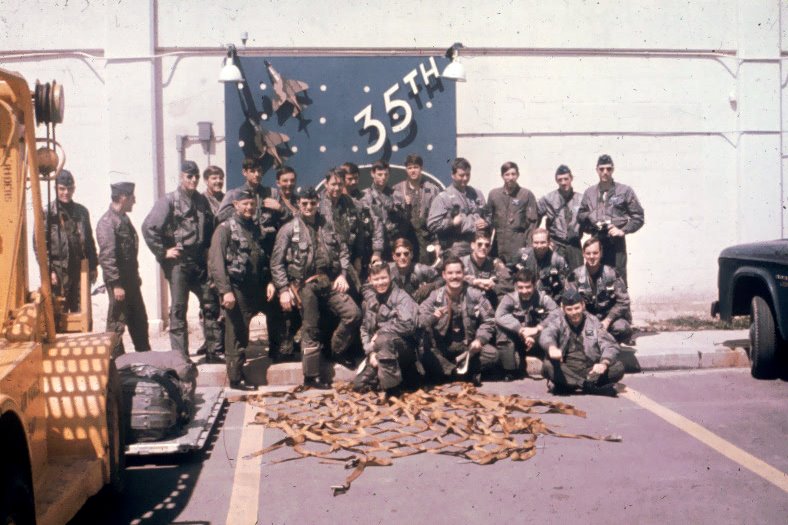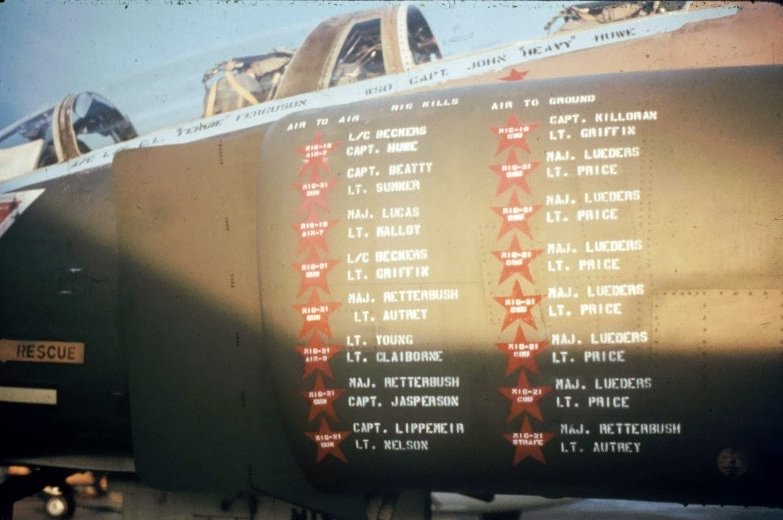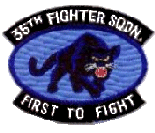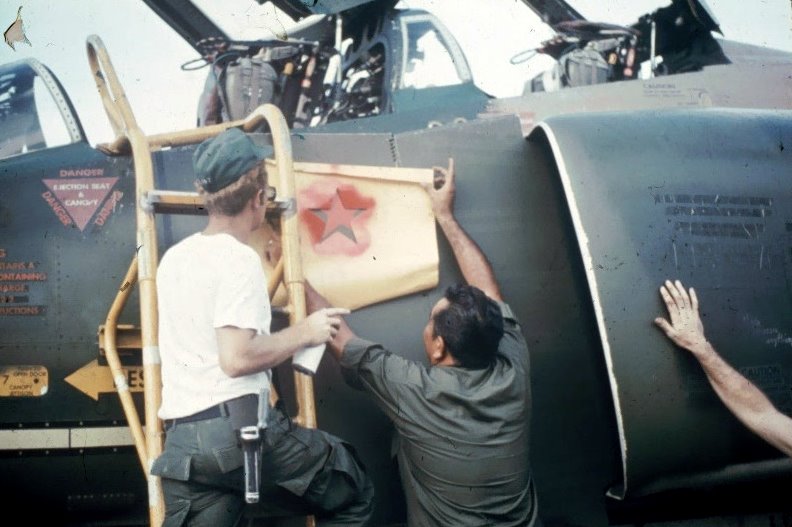35th Tactical Fighter Squadron MiG Kills
On April 1, 1972, while members of the 35th Tactical Fighter Squadron at Kunsan Air Base, Korea, slept, an early morning phone call summoned USAF Colonel Tyler G. Goodman to the 3rd Tactical Fighter Wing command post. After communicating with 5th Air Force headquarters in Japan via the secure “walk-talk” teletype system, Colonel Goodman instituted the squadron’s silent recall procedure, which was designed to reduce the chances that nonessential personnel would know of the recall.
Thus began the April Fool’s day deployment of the 35th TFS to Vietnam and Thailand to participate in the “Southeast Asia War Games” and Operation Linebacker I. Later that day, 14 F-Ds departed Kunsan Air Base for Clark Air Base, Philippines. On April 5, 1972, 35th TFS crews began flying combat missions from Ubon Air Base, Thailand. The following day, other 35th TFS crews began flying combat missions from DaNang Air Base, South Vietnam.

Some of the 35th TFS Guys Pose for a Group Photo in front of the Squadron Building Just Prior to Departing Kunsan AB, Korea, for Southeast Asia.
The 35th TFS soon consolidated the squadron and moved all of its men and F-4Ds to Korat Royal Thai Air Base, Thailand, where I joined it. During the summer and fall of 1972 as part of Operation Linebacker I, the 35th TFS conducted strike escort missions into Route Pack VI, the most heavily defended area in the history of aerial warfare. Each strike escort mission consisted of four 35th TFS F-4s flying in “fluid four” formation on the perimeter of the strike force (the F-4s carrying bombs) as the strike force ingressed and egressed the target in Route Pack VI. The strike escorts usually flew the F-4E armed with four AIM-9 Sidewinder heat seeking missiles, 3 or 4 AIM-7 Sparrow radar guided missiles and one six barreled 20MM gatling gun. When a strike escort carried only three Sparrows, it was because a single AIM-7 missile was replaced by an ALQ-119 jamming pod that jammed enemy SA-2 Guideline surface to air missile (“SAM”) radars.
The SA-2 SAM was a 32 foot long flying supersonic telephone pole. The radar guided missile could fly Mach 3.5 (three and one half times the speed of sound) and had a range of 25 miles and a maximum altitude of 60,000 feet. It was a formidable weapon and responsible for the loss of many U.S. aircraft over North Vietnam. The missile had a warhead that weighed 195 kg (130 kg of which is high explosive) and could detonate via proximity (when it got as close as it was going to get), contact and command fusing. At the altitudes F-4s flew over North Vietnam, the missile had a kill radius of approximately 65 meters, but anything within 100-120 meters of the detonation would be severely damaged.
The strike escort F-4s were the second line of defense if enemy MiGs got past the MiG CAP (combat air patrol) F-4s. The job of the strike escorts was to engage and destroy MiGs that threatened the strike force. If the MiGs got too close to the F-4 bombers, the bombers would be forced to jettison their bombs and take evasive action to avoid being shot down.
In the hierarchy of flying, the jet fighter is the pinnacle, but aerial combat is the fighter pilot’s ultimate experience. Tom Wolfe said that fighter pilots “have the right stuff” in his best selling book of the same name. Tom also wrote a short story called “Jousting with Sam and Charlie, the Truest Sport.” It is about a Navy F-4 crew that took off from a US aircraft carrier and got shot down by a surface to air missile (a “SAM”). The crew was rescued from the Gulf of Tonkin by a Navy helicopter and ate dinner that night in the officer’s mess / ward room or whatever the Navy guys called it. I believe the short story is in Wolfe’s book called “Mauve Gloves & Madmen, Clutter & Vine.” It was first published in a magazine, but I cannot remember which one.
In 1980 I was working on a masters degree in tax law at New York University School of Law. Tom Wolfe gave a talk to the students about his book “The Right Stuff.” I attended and found it very interesting. Tom spoke about a chapter he wrote for the book, but his editor didn’t let him put in the final version because it didn’t have anything to do with the rest of the book. Wolfe spent a lot of time researching “The Right Stuff” by hanging out with fighter pilots on Air Force and Navy bases. The deleted chapter was all about fighter pilots and what it was like to fly fighters in the US military. Tom said that his research showed that most fighter pilots were white Anglo Saxon protestants who were first born sons.
After Tom finished the speech he came into the audience and talked to people and signed autographs. I approached him from behind and waited for a chance to get his attention. I finally called out “Mr. Wolfe,” but he did not turn around. I then said “I am a white Anglo Saxon protestant first born son who flew F-4s in Vietnam.” That got his attention. Tom turned around and we had a lively discussion for an extended period of time about flying fighters. Tom told me that I should read “Jousting with Sam and Charlie, the Truest Sport.”
A few weeks later, I was wasting time in the library. I grabbed a volume of bound magazines off the shelf and thumbed through it. By chance I came across “Jousting with Sam and Charlie, the Truest Sport.” Excellent story. What are the odds of randomly finding the story? I searched for the story on the net tonight, but only found references to it.
But, I digress. This is about the men of the 35th Tactical Fighter Squadron who achieved the ultimate fighter pilot dream, to engage and destroy an enemy MiG in aerial combat. The vast majority of military pilots who flew in the Vietnam war were not fighter pilots so they never had a chance to engage a MiG. Most fighter pilots who flew in the Vietnam war never flew into North Vietnam where the MiGs were. Most of the fighter pilots who flew into North Vietnam never engaged a MiG. The fraternity of Vietnam era fighter pilots who actually engaged a MiG in life or death aerial combat is very small and very elite.

Lt. Colonel Ferguson’s F-4D that he flew back to Kunsan AB, Korea, in October 1972 when the 35 TFS RTBd.
Ask Joe Lee Burns or Gary Rettebush Why 8 Air to Air MiG Kills are Listed
Official USAF Records Credit the 35 TFS with 6 MiG Kills
My squadron had a lot of members of the aerial combat fraternity because it was tasked with the strike escort mission in Route Pack VI. The following table lists the members of the 35th Tactical Fighter Squadron who were credited with MiG kills during the time we were TDY to Korat Air Base, Thailand, in the summer and fall of 1972. When they made their kills, all of the aircrews were flying the F-4E with the internal 20MM six-barrel gatling gun.
- Lt. Col. Lyle Beckers & Capt. John Huwe
Call sign: Balter 01
MiG-19 with an AIM-7 Sparrow
- Capt. James Beatty Jr. & Lt. James Sumner
Call sign: Balter 03
MiG-21 with the 20MM cannon
- Major Jon Lucas* & Lt. Douglas Malloy
Call sign: Eagle 3
MiG-19 with an AIM-7 Sparrow
- Lt. Col. Lyle Beckers & Lt. Thomas Griffin
Call sign: Finch 01
MiG-21 with an AIM-9 Sidewinder
- Major Gary Retterbush & Lt. Daniel Autrey
Call sign: Finch 03
MiG-21 with the 20MM cannon
- Major Gary Retterbush & Capt. Robert Jasperson
Call sign: Lark 01
MiG-21 with the 20MM cannon
Read Gary Retterbush’s article on his MiG kills called “Gary Retterbush 2 – North Vietnamese Air Force 0.”
*Major Lucas was a 34th Tactical Fighter Squadron pilot.
Dan Autrey was my roommate. Dan and Gary Retterbush were awarded the Silver Star for their kill. Dan made a great tape recording of a mission north of Hanoi during which he and Gary Retterbush had a spoofed SAM launched at them while they were attacked by two MiG-21s from low and behind that each fired two Atoll heat seeking missiles at them. Dan told me after the mission what it felt like when he heard Lt. Col. Beckers in Lark 01 call “Lark 3 break left.” Dan looked to his F-4’s seven o’clock position, saw four supersonic missiles coming at him and said “oh shit, left, left, left.” I have the tape and will soon write a story about that close encounter of the frightening kind.


